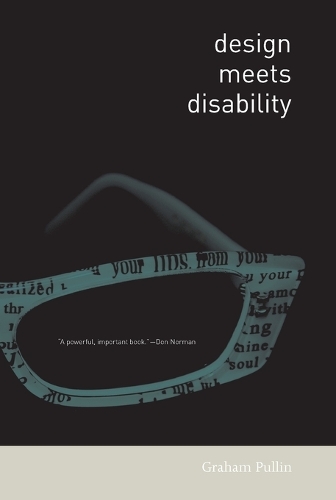
Design Meets Disability
(Paperback)
Publishing Details
Design Meets Disability
By (Author) Graham Pullin
MIT Press Ltd
MIT Press
30th September 2011
United States
Classifications
Adult Education
Non Fiction
745.2
Physical Properties
Paperback
368
Width 137mm, Height 203mm, Spine 21mm
590g
Description
How design for disabled people and mainstream design could inspire, provoke, and radically change each other.Eyeglasses have been transformed from medical necessity to fashion accessory. This revolution has come about through embracing the design culture of the fashion industry. Why shouldn't design sensibilities also be applied to hearing aids, prosthetic limbs, and communication aids In return, disability can provoke radical new directions in mainstream design. Charles and Ray Eames's iconic furniture was inspired by a molded plywood leg splint that they designed for injured and disabled servicemen. Designers today could be similarly inspired by disability. In Design Meets Disability, Graham Pullin shows us how design and disability can inspire each other. In the Eameses' work there was a healthy tension between cut-to-the-chase problem solving and more playful explorations. Pullin offers examples of how design can meet disability today. Why, he asks, shouldn't hearing aids be as fashionable as eyewear What new forms of braille signage might proliferate if designers kept both sighted and visually impaired people in mind Can simple designs avoid the need for complicated accessibility features Can such emerging design methods as "experience prototyping" and "critical design" complement clinical trials Pullin also presents a series of interviews with leading designers about specific disability design projects, including stepstools for people with restricted growth, prosthetic legs (and whether they can be both honest and beautifully designed), and text-to-speech technology with tone of voice. When design meets disability, the diversity of complementary, even contradictory, approaches can enrich each field. How design for disabled people and mainstream design could inspire, provoke, and radically change each other.Eyeglasses have been transformed from medical necessity to fashion accessory. This revolution has come about through embracing the design culture of the fashion industry. Why shouldn't design sensibilities also be applied to hearing aids, prosthetic limbs, and communication aids In return, disability can provoke radical new directions in mainstream design. Charles and Ray Eames's iconic furniture was inspired by a molded plywood leg splint that they designed for injured and disabled servicemen. Designers today could be similarly inspired by disability. In Design Meets Disability, Graham Pullin shows us how design and disability can inspire each other. In the Eameses' work there was a healthy tension between cut-to-the-chase problem solving and more playful explorations. Pullin offers examples of how design can meet disability today. Why, he asks, shouldn't hearing aids be as fashionable as eyewear What new forms of braille signage might proliferate if designers kept both sighted and visually impaired people in mind Can simple designs avoid the need for complicated accessibility features Can such emerging design methods as "experience prototyping" and "critical design" complement clinical trials Pullin also presents a series of interviews with leading designers about specific disability design projects, including stepstools for people with restricted growth, prosthetic legs (and whether they can be both honest and beautifully designed), and text-to-speech technology with tone of voice. When design meets disability, the diversity of complementary, even contradictory, approaches can enrich each field.
Reviews
Design Meets Disability may be compared to Donald Norman's (1988) Psychology of Everyday Things, which showed how research in cognitive psychology can inform commercial design. Similarly, Design Meets Disability explains how commercial design principles can be used to make more personally identifiable and valuable assistive technologies. As important as Norman's book was to technology design, Design Meets Disability could have a similar impact within the AT field.
* Augmentative and Alternative Communication *The book... acts as a manifesto by condemning many of the existing products designed for people with disabilities, and challenging designers to use their skills to develop inspiring alternatives.
* The New York Times *Author Bio
Graham Pullin is a lecturer in Interactive Media Design at the University of Dundee. He has worked as a senior designer at IDEO, one of the world's leading design consultancies, and at the Bath Institute of Medical Engineering, a prominent rehabilitation engineering center in the United Kingdom. He has received international design awards for design for disability and for mainstream products.
